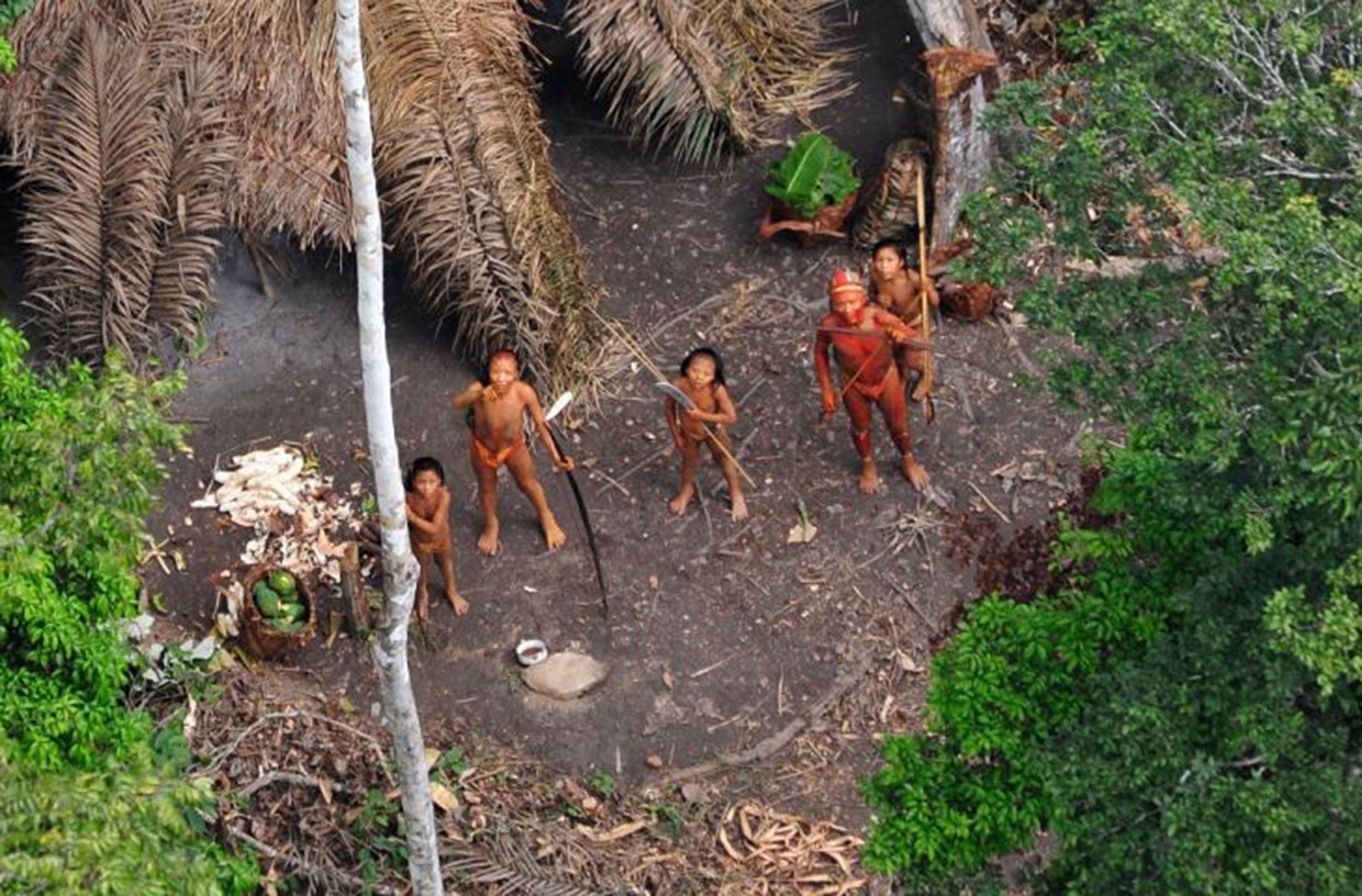A fatal clash of civilisations? 'Lost' Amazonian tribe under threat from illegal loggers operating in their traditional territories
The world was gripped by the sight of a previously uncontacted tribe in the Brazilian rainforest three years ago. What happened next has only just emerged – and it suggests their very existence is under threat

At first they were little more than fleeting sightings of naked figures on the edge of the forest. But as the days went by, the men and boys grew bolder, venturing into the village to pilfer pots and vegetables before disappearing back into the safety of trees.
After they were first glimpsed by other people on the outskirts of an Asháninka indigenous community on the upper reaches of Brazil’s Envira River, “a few dozen” members of an unnamed Amazonian tribe finally made contact with a settled population 20 days ago. That came four years after a tribal group, reportedly from the same Amazonian tribe, were filmed from the air in 2010. When the images were released in January 2011, they created a worldwide sensation.
It is believed the tribe had been driven across the border from their centuries’ old nomadic existence by the activities of illegal loggers and possibly drug-traffickers operating in their traditional territories in Peru. Brazil’s Indian Affairs Department, Funai, confirmed that the group had taken the momentous decision to make contact at the village of Sympatico in the state of Acre, more than a week’s travel by foot and canoe from the nearest road.
Sympatico, just 25 miles from the border, is very close to the area where a tribe group was filmed four years ago. It is estimated that there are at least four such communities living in Acre, constituting a population of around 600. A further two tribes are believed to occupy territory in Peru. But no one knows exactly how many individuals there are now living in the pristine forest of the western Amazon.
What is known, however, is that international concern over the presence of heavily armed loggers in Peru has been growing, sparking warnings that their activities could mean the end for the world’s last “lost” tribes. The mahogany and teak harvested by the gangs is believed to be destined to be made into garden furniture in Europe or the United States. Under international law the Indians have the right to their own traditional territories.
It is the first time since monitoring of the area began in the 1980s that a tribe has ventured forth willingly. “Contact was made and the situation continues to be peaceful,” Funai said. The group is said to have requested food and clothes.
José Carlos Meirelles, who has monitored this region for the department for 20 years, said the situation was unique. “Something serious must have happened. It is not normal for such a large group of uncontacted Indians to approach in this way. This is a completely new and worrying situation and we do not know what has caused it,” he said.
Now is the most perilous time for the Indians, it is warned. For the first time since their forefathers escaped the genocidal impact of the 19th-century rubber boom, they face new viruses – chicken pox, measles even the common cold – to which they have no immunity. Relocation also brings new threats of conflict with settled groups.
Under Brazilian law the state pursues a no-contact policy, allowing the indigenous groups to choose if they wish to engage with people.
Funai already has doctors and linguistic specialists in the area. At present though the tribe is co-existing with their new found Asháninka hosts. Despite being initially frightened, the Asháninka are said to be deeply moved by the plight of their fellow forest-dwellers.
Sarah Shenker, of the human rights organisation Survival International, which campaigns on behalf of indigenous people, said no one yet knew which language the Indians spoke. “We don’t know who they are,” she explained. “This is clearly a conscious decision to make contact because they must have felt they had no other choice. They really could face the prospect of being wiped out.”
Campaigners say pressure must be brought on the region’s governments to protect their lands and abide by the law. It is argued that aerial photos have shown the tribespeople are healthy and that their way of life – hunting, gathering and growing their own vegetables – is viable.
Despite recent accords signed between Peru and Brazil, which both respect the autonomy of the Indians, it is a lawless and bewilderingly remote region, where the gap between policy and practical enforcement can be huge.
Guard posts in Brazil meant to enforce the rights of the tribespeople have been occupied by drug-smuggling gangs. Meanwhile, in Peru there remains official resistance to the idea that uncontacted peoples still exist in the forest, with senior figures suggesting they remain a myth created by the environmental movement to prevent exploitation of the country’s resources.
But Nixiwaka Yawanawá, an Indian from Acre state, said he was from the same area as the newly contacted tribe: “It is very worrying that my relatives are at risk of disappearing. It shows the injustice we face today. They are even more vulnerable because they can’t communicate with the authorities. Both governments must act now to stop a disaster against my people.”
Subscribe to Independent Premium to bookmark this article
Want to bookmark your favourite articles and stories to read or reference later? Start your Independent Premium subscription today.

Join our commenting forum
Join thought-provoking conversations, follow other Independent readers and see their replies